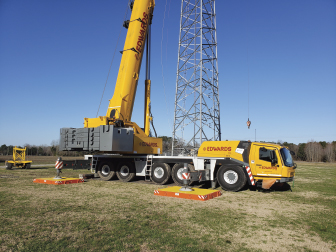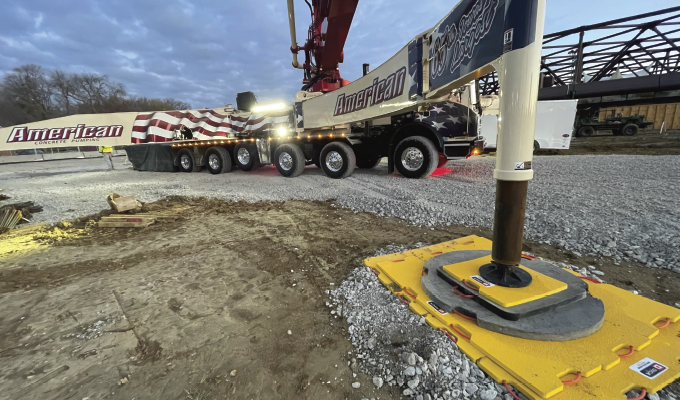Two important properties to understand when evaluating outrigger pads and crane pads are the material’s strength and stiffness. Products used by cranes, digger derricks, boom trucks, concrete pumpers, and similar applications must be both strong enough to prevent breaking (physical failure), and rigid enough to resist bending (functional failure), while distributing the load over an intended area.
BEAR AND SUPPORT
Why is the difference between strength and stiffness important to proper product selection? Well, according to David Duerr, PE, 2DM Associates, Inc., outrigger pads or crane pads must, “Spread the load from the crane over a large enough area that the bearing pressure to the ground surface is acceptable [and] provide support to the crane that is stiff enough that the crane will not go out of level as the loads from the crane change during lifting operations.” Stiffness is required to spread the load, and the combination of both strength and stiffness is required to prevent the crane from going out of level.
When evaluating outrigger and crane pad products, it is important to understand how the attributes of strength and stiffness vary with different materials and designs, and, in turn, how that affects the safety and performance of the products. Selecting the right combination is a critical decision.
For purposes of this discussion, strength and stiffness are defined as:
- Strength (yield strength) is the ability of the material to support a load without breaking (physical failure)
- Stiffness (bending stiffness) is the ability of the material to resist bending and deflection (functional failure)

PROPERTY DIFFERENCES
Stronger does not mean stiffer. An outrigger pad may have enough strength to not break, however, this same pad may not be stiff enough to effectively distribute the load to the ground due to excessive deflection. The ability of an outrigger pad to spread the load is based on the stiffness of the pad relative to the stiffness of the soil. If the pad is not rigid enough, the load will be concentrated on a smaller area on the pad. This results in increased ground bearing pressure which will cause more pad deformation and deflection, which could lead to both functional and physical failures. This challenge will intensify as the stiffness of the ground increases.
The strength and stiffness of a pad will depend on the makeup and thickness of the material. Material strengths and stiffness properties are generally understood through the use of standardized material testing and analysis.
In this discussion, plastic can be considered to be stronger than wood, because it’s more resistant to failure in bending. Most wood is stiffer than plastic, but it is also more brittle. Since wood is not as strong as plastic, thickness must be increased to avoid breaking. As plastic is not as stiff as wood, thickness may need to be increased to distribute loads and resist deflection more effectively.
The load carrying capacity and stiffness of a pad is directly related to its thickness, though in varying degrees. Expanding material thickness increases the load distribution performance of outrigger pads and crane pads. The reverse is also true and increases chances of physical failure.
The difference between strength and stiffness can be thought of this way:
- A stiffer pad with less strength will break if a load or pressure is exerted on the pad that exceeds its limits.
- A stronger pad that is not as stiff will deflect under loads that exceed the combined stiffness of the pad and ground.
- Deflection is a warning sign that signals the need for more foundation support due to higher loads, and/or softer soils.
CONSIDERING MATERIALS
Wood is an organic material, meaning its properties and performance change with exposure to the environment, moisture, chemicals, and usage. Wood begins to deteriorate and decay the moment it is cut. Exposure to the environment and stress from loads increase its rate of deterioration.
Polyethylene plastics, or thermoplastics, used in making outrigger pads and crane pads are engineered materials that should not be susceptible to environmental exposure, moisture, chemicals, and usage. These materials do not deteriorate or decay over time and do not fatigue from loading when used within rated guidelines.
Composites such as Fiber Reinforced Polymers (FRP) are engineered materials that should not be susceptible to environmental exposure, moisture, chemicals, and usage. These materials do not deteriorate or decay and will not fatigue from loading when used within the rated guidelines.
CLOSING THOUGHT
Understanding the different roles that strength and stiffness play is essential to making decisions about the foundational support the equipment needs for the application. The most reliable way to do this is to work with a supplier or engineer who understands how different materials and product designs interact with equipment loads and the ground.
About the Author:
Kris Koberg is the CEO of DICA. For more, visit www.dicausa.com.
Modern Contractor Solutions, October 2023
Did you enjoy this article?
Subscribe to the FREE Digital Edition of Modern Contractor Solutions magazine.



